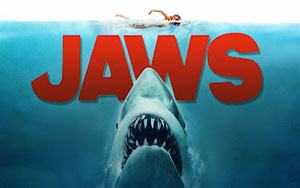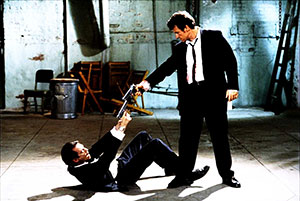
Sick of soul-less Hollywood blockbusters? Me too. But I’ve also had a gutful of two-act, too-cool-for-school indie pics. I’m proposing a crazy idea – a rapprochement between Character and Story. No, really, I think it can work.
When an indie auteur says their film is character-driven, too often what they really mean is that it’s not driven at all.
What’s wrong with Hollywood blockbusters?
I don’t see many tentpole pics. I didn’t go to Man of Steel, World War Z or whatever the last Batman film was called. I do occasionally feel obliged to see what all the fuss is about, but when I do venture into a multiplex I only have my worst fears confirmed. Like with The Avengers, for example. It’s third on the all-time worldwide box office list and clearly Joss Whedon is an incredibly talented individual but this Marvel Comics amalgam is not my idea of a good time.
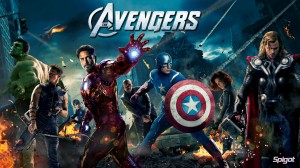
Joss Whedon is a genius and RDj provides a few highlights but the film is plagued by the thing that limits most studio pics – a lack of soul.
The 3 things that turn me off about Hollywood Blockbusters
1. Flat characterisations – The characters in too many blockbusters tend to be two-dimensional which diminishes their authenticity and limits their ability to wholly engage the emotions. (Iron Man, within The Avengers, is the exception that proves the rule.)
2. Plot-driven structures – The writers will show some understanding of structure but their preoccupation tends to be plot rather than character and, in the absence of an integrated, authentic character arc, the climaxes generally leave us cold, no matter how much we might applaud the efforts of their CGI department.
3. Hollow as a crack pipe – But, fundamentally, the thing that turns me off most studio pictures is that they lack soul. It’s not just that they don’t seem to have anything to say about the human condition, it’s that they rarely seem to be written from the heart. They don’t appear to be inspired by the pain or revelation of personal experience, so the films tend to be all surface and no substance.
True, the blockbuster, with its combination of high concept, whiz-bang spectacle and star-power up the yin-yang, can generally draw a crowd, but it doesn’t mean the punters go home satisfied.
I overhead someone at my local café giving his impressions of Man of Steel: “Yeah, the first half was pretty good but then the second half, it just kind of petered out. It was kind of disappointing.”
Kind of disappointing. Yeah, that would sum up my experience of most Hollywood blockbusters. They just don’t move me.
What Hollywood pics can learn from the indies
On the plus side, most indie films don’t suffer from the typical blockbuster maladies I’ve cited. They generally have …
1. More authentic characters – They tend to be more three-dimensional, have more contradictions and consequently feel more real so we’re willing to engage with them, even when they do things that most people don’t – and really shouldn’t – do.
2. Less plot-preoccupation – Indie films generally won’t be accused of being formulaic or of allowing plot to obliterate character (though more on this shortly).
3. More smarts – While I don’t think you could say that the average indie film writer is more intelligent or better read than the writer of the average Hollywood blockbuster, I do think it would be fair to say that indie operatives are less afraid to display that intelligence and worldliness.
4. More soul – The average indie film feels more personal. The writer has generally invested something of themselves in the script and you sense that they have brought this to the screen not because of the likely financial rewards but in spite of the enormous personal sacrifices. You feel the writer has felt something or realised something that they’re desperate to share, even if it means exposing their deepest, darkest vulnerabilities. It’s like comparing home-made lasagna with something out of a carton; when it’s made with love, you can really taste the difference.
So what’s my beef with a lot of indie films?
While I definitely prefer indie flicks to studio pics, I often leave them similarly disappointed, and it’s for the same reason. For all the heart that goes into them, they too rarely move me.
There are number of reasons why this is the case, but almost all of the weaknesses I see in indie films seem to be a reaction – an over-reaction – to their desire to distance themselves from mainstream cinema.
I would make these observations about a lot of indie films:
1. Oblivious to the audience
Most in the indie sphere are sickened by Hollywood’s shameless pursuit of box office glory, and I get that. But, in attempting to avoid making this mistake, a lot of indie cinema is diminished by its comprehensive disregard for the fundamental desires of the audience. The writer is so preoccupied with their unique vision, they fail to consider what might be in this intensely personal odyssey for the rest of us. Injecting the self seems too often to slip into self-indulgence.
2. Say it without showing it
Indie film-makers will decry the fact that Hollywood Blockbusters aren’t about anything, and be determined that their films have something to say. Nothing wrong with that. But, unfortunately, too often what they have to say is spoken but not dramatised. The philosophy of the film-maker can be learned from the dialogue but it’s not demonstrated by the story. This tends to be neither entertaining nor persuasive and it must have Lajos Egri turning in his grave.
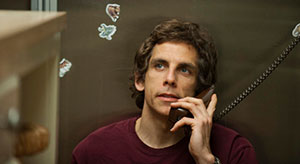
Greenberg is a good example of an indie that has something to say but makes the mistake of saying it rather than dramatising it.
3. Not character-driven but character-paralysed
The indie sector will charge studio films with favouring plot at the expense of character. Fair call. But, in attempting to shift the focus from the machinations of the plot to the psychology of the players, many indie films have seriously undercooked the narrative.
When an indie auteur says their film is character-driven, too often what they really mean is that it’s not driven at all. Why is this a bad thing, I hear you scream?
Because without plot, you aren’t able to challenge and provoke your characters to reveal the more sensitive dimensions that they – and we as humans – tend to want to keep hidden. So we will be initially engaged by the authenticity of the characters in a lot of indie films but, when they aren’t pushed by the narrative into uncomfortable places and they remain just as they were when we first met them, we often lose interest after the hour mark and we’re rarely moved by what they do just before the credits roll.
Ironically, in building an altar to the God of Character, a lot of indie cinema limits the opportunities to deepen characterisation – and our engagement.
4. The demonisation of structure
Indie film-makers tend to ascribe the problems of Hollywood to the popularisation of the story theorists – from Syd Field to Robert McKee and Blake Snyder. And it’s true that the mindless application of screenwriting paradigms can have dire results. But, the baby has been thrown out with the bathwater.
Structure is not the enemy.
Structure is not a Hollywood invention. As Joseph Campbell observed, no matter who we are, or where we are, or when we are, we all tell stories and those stories – the ones that have endured at least – tend to have a similar shape. Why? Because the experience of being human is largely similar.
We set out on life’s grand adventure with vigorous ignorance and end it in frail wisdom. Story relates that bitter-sweet transformation – and helps us come to terms with it.
Well, it can, but if only if that story is well told.
And there’s the rub.
In turning their backs on structure because they feel it’s what undermines the movies of Hollywood, many indie film-makers struggle to convert their first-rate characterisation into a bona-fide story. And, as a consequence, too many indie films don’t realise their emotional potential and don’t do for me what I want a story to do for me. They don’t help me with being human.
Time for détente in the Hollywood-Indie war
So too many studio pics lack character. And too many indie pics are weak on story. Here’s a novel idea. How about we have Character and Story appear in the same movie?
By drawing on the best of both worlds, would it not be possible, theoretically, to create a film that had authentic, well-rounded but deeply flawed characters who engage us, and a story that challenged those characters, deepened our engagement, and whose resolution revealed (rather than declared) something about the human condition? Could we not produce a genuinely Character-Driven Crowd Pleaser?
In truth, I can’t claim that this radical notion of Character and Story co-existing within the one screenplay is my invention. It used to be reasonably commonplace.
When Character and Story were best of friends
For most of last century, there wasn’t this divide between what the “smart” people watched and what the broader audience consumed.
Hollywood studios were run by people who, it’s true, had an eye for the dollar but they also had a great passion for story.
As a consequence, in its Golden Age, Hollywood produced films that had the capacity to draw crowds and seduce critics, that had great characters in powerful stories exploring metaphysical concerns that in no way precluded the simultaneous consumption of popcorn. Consider the work of directors like Charlie Chaplin, Alfred Hitchcock, Michael Curtiz, John Ford, John Huston, David Lean, William Wyler, George Stevens, Elia Kazan, and, my personal favourite, Billy Wilder.
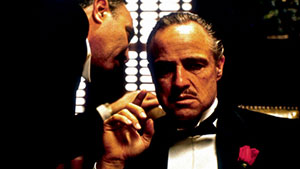
Hollywood was still delivering smart films of broad appeal until the mid-70s but very soon, things went south …
Francis Ford Coppola continued this Hollywood tradition of making smart, commercially successful movies through into the mid-70s. The Godfather and its successor were challenging, powerful films with complex characters, escalating narratives and ambivalent yet emotionally satisfying resolutions that filled cinemas and dominated the Oscars.
It was all going so well. But, then, suddenly, after the happiest of marriages, Character and Story fell out.
Where did it all go wrong?
I blame Jaws.
Don’t get me wrong. I like Jaws. But, in 1975, the enormous financial success of this film – $471m gross on a budget of $9m – at a time when the proprietorship of the studios was moving out of the hands of passionate, hands-on owners and into the clutches of disengaged bean counters, changed the industry forever.
From here on in, Hollywood seemed to be less concerned with making great films and more concerned with making inordinately large profits, and the style of films changed as a consequence.
In search of the blockbuster “event” movie, budgets flew higher, the perceived common denominator dived lower, characterisations got thinner and soul was dispatched to the backlots to make room for the merchandising department.
And, for the most part, it worked for them. Hollywood made pots of money.
But, in chasing the buck, they alienated the smart set and indie cinema arose to meet the needs of filmmakers and audiences disaffected with the New Hollywood.
Unfortunately, now nearly forty years on from Jaws, the two camps have diverged too far, to the detriment of both mainstream and literate audiences, because each is missing critical pieces of the cinematic storytelling puzzle.
So I’m proposing a reconciliation between the long-estranged Character and Story and a return to making films the old fashioned way.
I don’t think this constitutes box office suicide or that it represents an artistic capitulation. Characterisations don’t need to be simplistic to win an audience.
And films can have well-structured plots without insulting our intelligence.
By tearing down this partition, I think we can still make films with heart that have something to say; they’ll just say it more powerfully, and touch us more deeply as they do so.
I genuinely believe you can make the Character-Driven Crowd Pleaser. And I don’t think I’m dreaming. Some filmmakers – mostly in the indie sector it has to be said – have been doing exactly this.
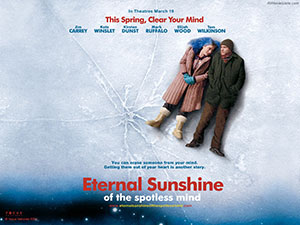
Now we’re talking … big idea, strong characters, great story, something to say … Eternal Sunshine pulled an audience and will charm audiences for ever.
Films that have done well both commercially and critically in recent times through the artful articulation of Character and Story include:
- Eternal Sunshine of the Spotless Mind
- Juno
- Sideways
- The Lives Of Others
- The King’s Speech
- Little Miss Sunshine
These intelligent, moving films all had small budgets, pulled large audiences and their film-makers got to wear tuxedos and nice frocks on Oscar night. Would you be unhappy if your film did something similar?
In my next post, I’ll identify the very special kind of kind of story that can reunite the currently disparate Hollywood and Indie audiences and achieve the filmmaking Holy Grail: critical and commercial success. I call it the Transcendent Story.
When is my next 2-day screenwriting course?
Please add me to the Cracking Yarns mailing list.
You might also like to read:
The new character-driven Hero’s Journey
